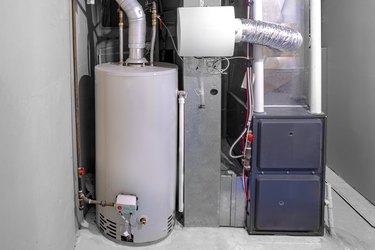
Furnace manufacturers have all but phased out standing pilot ignition systems for gas furnaces, so if you have to light the pilot light on your Trane furnace, it's because the furnace is more than 20 years old. Newer gas furnaces use electronic ignitors, and if something goes wrong with them, the furnace LEDs will flash a code to tell you the problem. These ignitors can wear out quickly, but they're usually inexpensive and easy to replace. Older furnaces, such as the Trane XE60, don't have these LEDs, and if the furnace isn't producing heat, you have to visually inspect the burner to see if the pilot is on.
If the pilot is off, you can relight it yourself, but there's a reason it went off, and that may indicate the need for servicing. Two common reasons for the pilot to go out are carbon buildup in the pilot tube and a faulty thermocouple, and while homeowners can fix these problems themselves, a pro can do a better job while giving the furnace the TLC it needs.
Video of the Day
Video of the Day
Things You'll Need
How to Light a Trane Standing Pilot
Step 1: Turn Down the Thermostat
You don't want the furnace burners to switch on while you're working, so turn down the room thermostat to its lowest setting. If the furnace has a power switch, you can just turn that off as an alternative.
Step 2: Locate the Pilot
Take off the furnace cover and locate the gas valve and the gas control, which is a plastic or metal knob with three settings: "on," "off" and "pilot." You'll see three tubes coming from the bottom of the gas valve. Follow one of the two smaller ones (the large one is for the gas burners) inside the burner compartment and note where they terminate, which is where you want to hold the flame to light the pilot. You may need a head lamp to see this termination point clearly.
Step 3: Start the Gas
Turn the gas control knob to "off" and wait a few minutes to let any residual gas dissipate. Then, turn it to "pilot" and push it in. At this point, gas will start flowing from the pilot orifice.
Step 4: Light the Flame
Hold a lit long-reach lighter over the pilot orifice until the pilot starts to burn. Continue holding in the gas control to give the thermocouple time to heat up. This usually takes 10 to 20 seconds.
Step 5: Repeat If Necessary
Release the gas control knob and verify that the pilot flame continues to burn. If it goes out, repeat the procedure from the beginning but hold in the gas control a little longer. Once the flame is burning, replace the furnace cover, turn the furnace back on and set the thermostat to the desired temperature.
Signs That the Furnace Needs Service
If you can light the pilot but it won't stay lit after you release the control, the thermocouple probably needs to be replaced. On the other hand, the pilot orifice probably needs to be cleaned if you can't light it at all, and you're sure there is gas flowing to the furnace. Both of these are good reasons to call a service tech. You should also consider calling for service if the pilot flame is weak or burning orange or yellow. A healthy pilot flame is bluish in color, is about an inch in height and burns steadily.